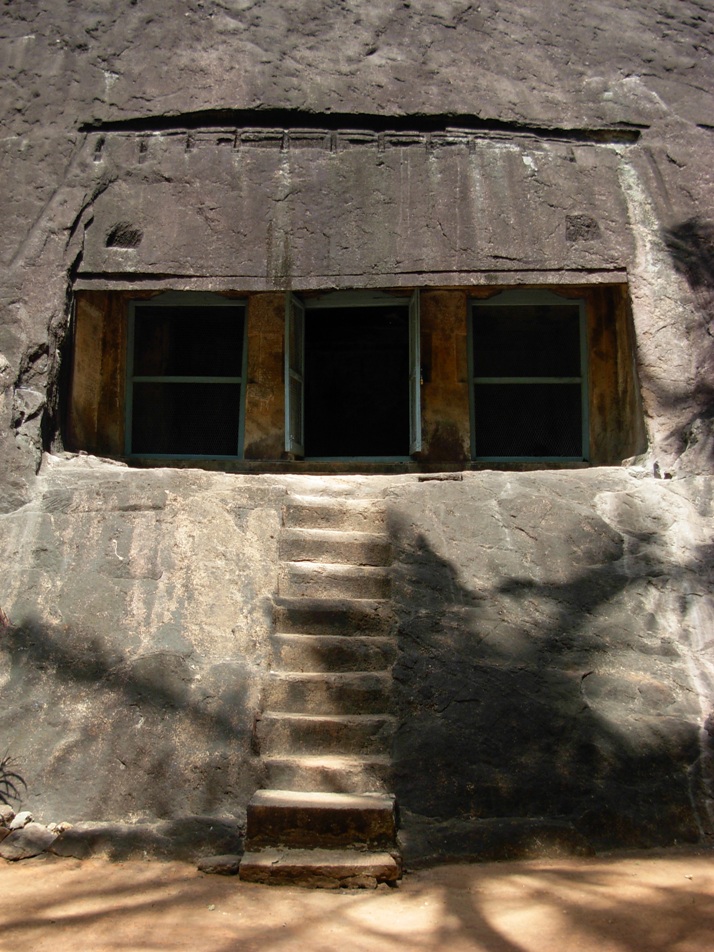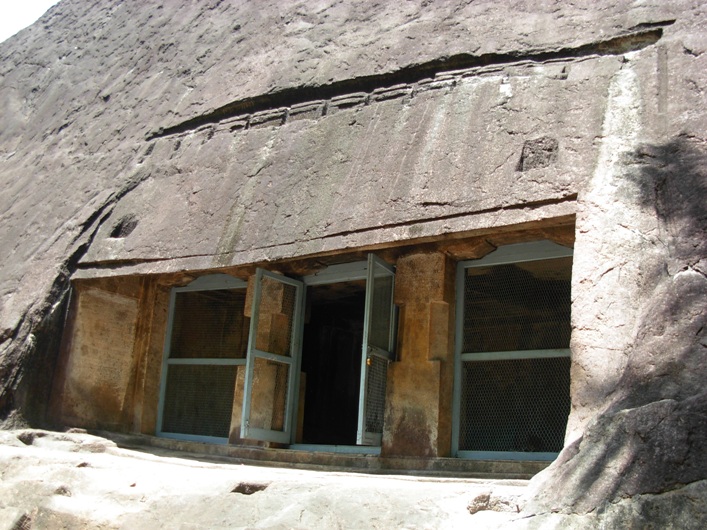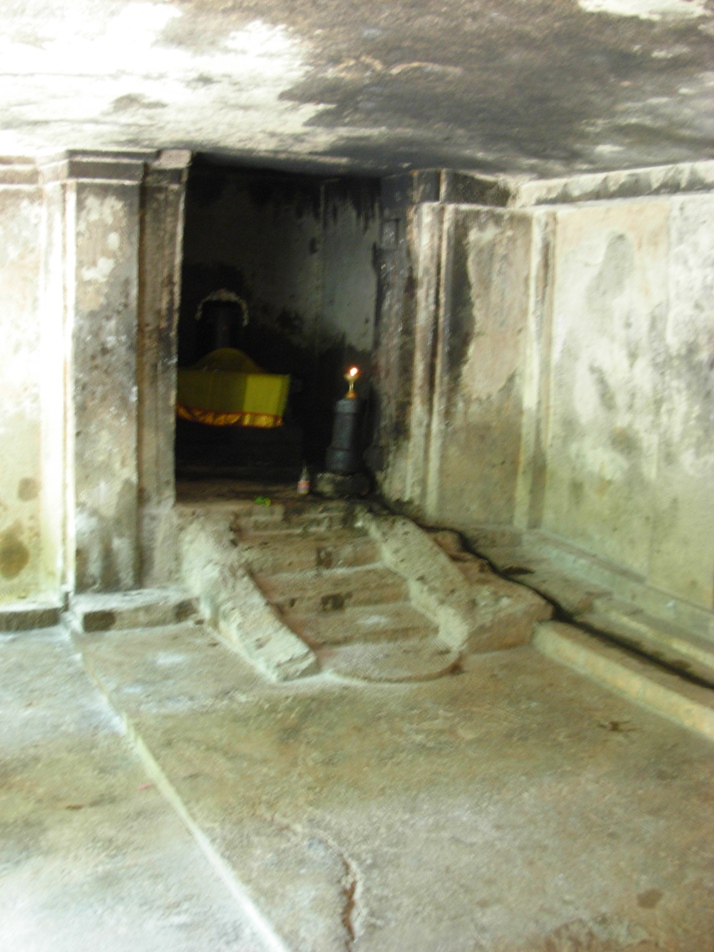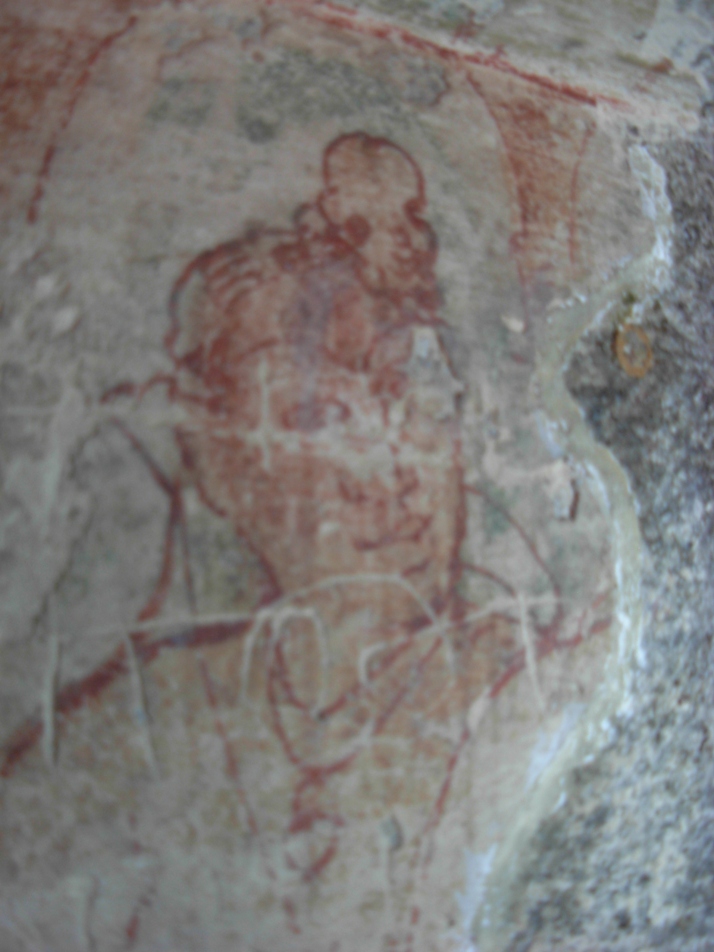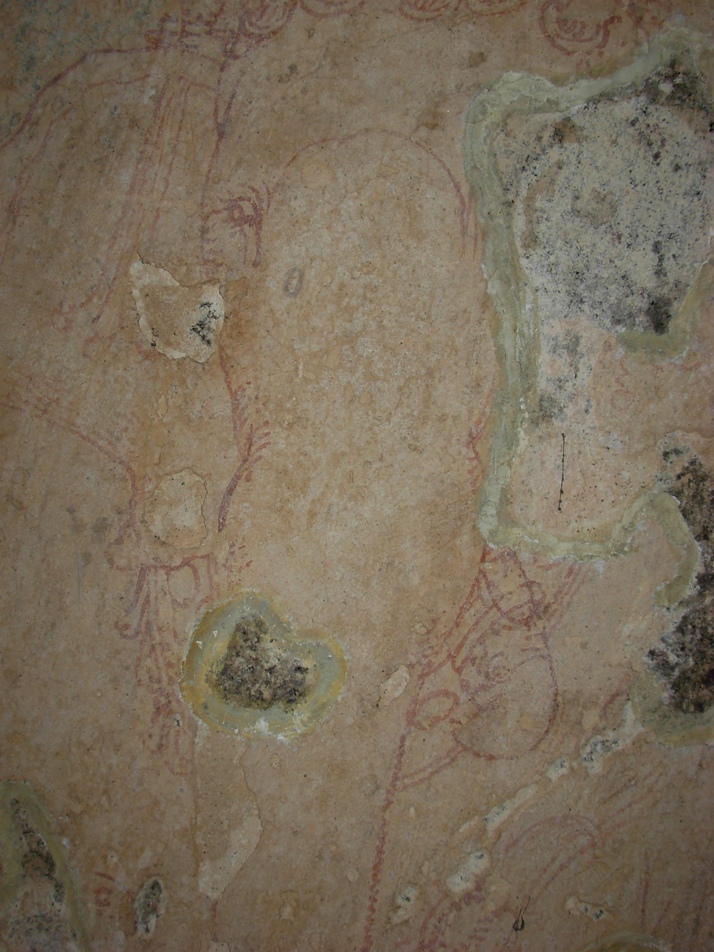 |
| Mahadevar Koil, Edaiyarpakkam |
 |
| Varalaru.com |
 |
Apsidal shape back view |


Mahadevar Temple is located in Edayarpakkam village, Sriperumbudur taluk, Kanchipuram district, Tamil Nadu, India PIN 631553. The temple is located 22 km towards North from district head quarters Kanchipuram; 19 km from Sriperumbudur; 12.5 km from Sunguvarchatram; 9.1 km from Thakkolam; 6.1 km from Arakkonam; 0.2 km from Elmyankottur; and 58 km from the state capital Chennai. This place is in the border of the Kanchipuram district and Thiruvallur district. The temple is protected by ASI.
The Chola period Mahadevar shrine is apsidal (horseshoe-shaped) dvitala (two tiered) vimana and an ardha-mandapam (அர்த்த-மண்டபம்). Therefore the vimana is called gajaprishta (கஜபிருஷ்ட விமானம்) or hastiprishta (ஹஸ்திபிருஷட விமானம்), both terms in Sanskrit meaning ‘back of an elephant’ as it is curved at the rear. According to dictionary.com the word 'apse' means a semicircular or polygonal termination or recess in a building.
According to most historians the apsidal form of vimana is of Buddhist origin. However current studies have confirmed that the apsidal vimana architecture was attempted by pan-Indian-tradition and the style was in existence much before the Buddhist era. This form of vimana is found in few other Chola temples in and around Chennai.
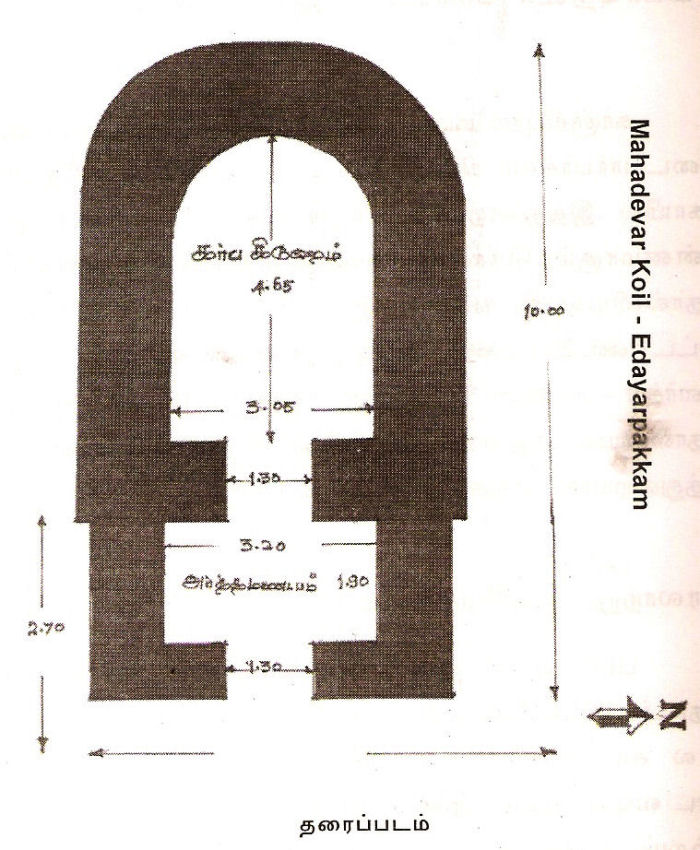
The entire temple structure is made out of granite and therefore it is a 'katrali' (கற்றளி). The vimana and ardhamandapam stands on a molded pada-bandha adishtana (பாதபந்த அதிஷ்டானா) with upa-peeta (உப பீடம்), jagadi (ஜகதி), tripatta kumuda (முப்பட்டைக் குமுதம்), khanta (கண்டம்) with pada and flanked by kampa (கம்பு) and pattika (பட்டிகை) mouldings. The east facing sanctum measures 3.05 m in width in the north-south direction and 4.65 m in length in the east-west direction. The sanctum entrance is 1.35 cm in width. The sanctum houses "Tiruppadakkadu udaiya Mahadevar" (திருப்படக்காடுடைய மகாதேவர்) in the form of Shivalingam.
The external walls of the vimana and ardhamandapam have five deeply cut niches (தேவகோட்டங்கள்) flanked by ornate square pilasters (அரைத்தூண்கள்). The niches on the south and north ardhamandapa walls houses the Chola style idols of Vinayaka and Durga respectively. The southern vimana wall houses the sanctum of the unique Dakshinamurthy appear seated on a pedestal under the Kallala tree (Banyan tree). The niche of the western vimana wall is empty. Brahma appear in the niche of the northern vimana wall.
Above the pilasters is the vettu potika holding the uttira. And the other roof parts are the vajana valabhi and kapota with rough kudu arches. Above the kapota is the bhumidesa denoting the end of the tala. Above the bhumidesa is seen the hara of the first tala. The hara components of second tala as well as griva, shikara and stupa (finial) might have got damaged and therefore not found at present.
Inscriptions
There are four inscriptions belonging to the later Chola period, especially that of Kulottunga Chola I (1070 - 1120 A.D.), Kulottunga Chola II (1133 - 1150 A.D.) and Rajadhiraja Chola II (1163 - 1178) are found at Edayarpakkam Mahadevar temple near Kanchipuram. The inscription (ARE 251/1910), (த நா அ தொ து 524/2013) dated 13th in the reign (year 1083 A.D.) of king Kulottunga Chola I opening with his venerated Prasasti (also known as Meikeerthi மெய்க்கீர்த்தி) is considered as the earliest inscription in this temple.
Inscriptions mention the prime deity of the temple as "Tiruppadakkadu udaiya Mahadevar" (திருப்படக்காடுடைய மகாதேவர்) as well as "Aludaiyar Tiruppadakkadu udaiyar" (ஆளுடையார் திருப்படக்காடுடையார்).
Inscriptions cite the name of this village as "Edayarruppakkam" (இடையாற்றுப்பாக்கம்). Present name seems to have transitioned from Edayarruppakkam to Edayarpakkam. Edayarruppakkam village fell under the revenue division of Purisai Nadu (புரிசை நாடு), which was a sub-division of Manavir-kottam (மணவிற் கோட்டம்) under the larger division of Jayamkonda Cholamandalam (ஜெயங்கொண்ட சோழமண்டலம்). (ஜெயங்கொண்ட சோழமண்டலத்து மணவிற்கோட்டத்துப் புரிசை நாட்டு இடையாற்றுப்பாக்கம்). The village was also known as Purisai (புரிசை) village fell under the same revenue division, part of same sub-division and coming under the same larger division (ஜெயங்கொண்ட சோழமண்டலத்து மணவிற்கோட்டத்துப் புரிசைநாட்டுப் புரிசை). The village was also popularly known as Rajavichadira Chaturvedi Mangalam (ராஜவிச்சாதிர சதுர்வேதிமங்கலம்).
The inscription (ARE 251/1910), (த நா அ தொ து 524/2013) is dated 13th in the reign (year 1083 A.D.) of king Kulottunga Chola I. It opens with his venerated Prasasti also known as Meikeerthi (மெய்க்கீர்த்தி). It records the gift of land as devadana (தேவதானம்) to Tiruppadakkadu udaiya Mahadevar by one Arurudaiyan Vaidyanatan Tiruchcirrambalamudaiyan in Kilar-kurram, a sub-division of Nittavinoda-valanadu of Chola Mandalam.
(3 .. ... ஜயங்கொண்ட சோழ மண்டலத்து மணவிற்கோட்டத்து ... சோழமண்டலத்து நித்த விநோத வளநாட்டுக் கிழாற் கூற்றத்து
4 .த்தங்குடி ஆரூர்ருடையாந் வைத்யநாதன் திருச்சீற்றம்பல முடையான் ... .)
The inscription (த நா அ தொ து 523/2013) is dated 13th in the reign (year 1107 A.D.) of king Kulottunga Chola I. It commences with his venerated Prasasti also known as Meikeerthi (மெய்க்கீர்த்தி). It records the gift of 95 sheep (சாவா மூவா பேராடு தொண்ணூற்றைந்து) for a perpetual lamps for the Lord Tiruppadakkadu udaiya Mahadevar at Purisai in Purisai Nadu, a sub-division of Manavir-kottam by Velan Madurantakan, the head man of Arasur, in Koneri-nadu in the Eyirk-kottam. (3 ... இம்மண்டலத்து எயிற்கோட்டத்துக் கோநேரி நாட்டுக் கோநேரியில் அரசூர்
கிழவந் வேளாந் மதுராந்தகநேன் .... )
The inscription (ARE 254/1910), (த நா அ தொ து 525/2013) is dated 12th in the reign (year 1145 A.D.) of king Kulottunga Chola II. It commences with his venerated Prasasti also known as Meikeerthi (மெய்க்கீர்த்தி). It records the gift of land purchased from the urar (ஊரார்) of Purisai, for a lamp to the temple of Aludaiyar Tiruppadakkadu udaiyar at Idaiyarruppakkam (இடையாற்றுப்பாக்கம்) alias Rajavichchadira Chaturvedimangalam (ராஜவிச்சாதிர சதுர்வேதிமங்கலம்) Purisai-nadu, a sub-division of Manavirkottam by a brahmana lady Andanaichchani, wife of Arulala pattan in the same village. (2 ... இவ்வூர் ஸவந்ந அருளாள பட்டந் மகள் ஆண்டமைச் சாநியேந் ...)
The inscription (ARE 253/1910), (த நா அ தொ து 526/2013) is dated 11th in the reign (year 1174 A.D.) of king Rajadhiraja Chola II. It records the gift of cows in exchange for a land in Purisai, granted by a brahmana lady of Idaiyarruppakkam (இடையாற்றுப்பாக்கம்) alias Rajavichchadira Chaturvedimangalam (ராஜவிச்சாதிர சதுர்வேதிமங்கலம்).
How to get there?
By road: Edayarruppakkam is the remote village and less traveled destination. The temple is also lesser known to the public. Public transport is not available. Rental cabs can be hired from Sunguvarchatram or Sri Perumbudur or Kanchipuram.
Reference

The entire temple structure is made out of granite and therefore it is a 'katrali' (கற்றளி). The vimana and ardhamandapam stands on a molded pada-bandha adishtana (பாதபந்த அதிஷ்டானா) with upa-peeta (உப பீடம்), jagadi (ஜகதி), tripatta kumuda (முப்பட்டைக் குமுதம்), khanta (கண்டம்) with pada and flanked by kampa (கம்பு) and pattika (பட்டிகை) mouldings. The east facing sanctum measures 3.05 m in width in the north-south direction and 4.65 m in length in the east-west direction. The sanctum entrance is 1.35 cm in width. The sanctum houses "Tiruppadakkadu udaiya Mahadevar" (திருப்படக்காடுடைய மகாதேவர்) in the form of Shivalingam.
The external walls of the vimana and ardhamandapam have five deeply cut niches (தேவகோட்டங்கள்) flanked by ornate square pilasters (அரைத்தூண்கள்). The niches on the south and north ardhamandapa walls houses the Chola style idols of Vinayaka and Durga respectively. The southern vimana wall houses the sanctum of the unique Dakshinamurthy appear seated on a pedestal under the Kallala tree (Banyan tree). The niche of the western vimana wall is empty. Brahma appear in the niche of the northern vimana wall.
Above the pilasters is the vettu potika holding the uttira. And the other roof parts are the vajana valabhi and kapota with rough kudu arches. Above the kapota is the bhumidesa denoting the end of the tala. Above the bhumidesa is seen the hara of the first tala. The hara components of second tala as well as griva, shikara and stupa (finial) might have got damaged and therefore not found at present.
Inscriptions
There are four inscriptions belonging to the later Chola period, especially that of Kulottunga Chola I (1070 - 1120 A.D.), Kulottunga Chola II (1133 - 1150 A.D.) and Rajadhiraja Chola II (1163 - 1178) are found at Edayarpakkam Mahadevar temple near Kanchipuram. The inscription (ARE 251/1910), (த நா அ தொ து 524/2013) dated 13th in the reign (year 1083 A.D.) of king Kulottunga Chola I opening with his venerated Prasasti (also known as Meikeerthi மெய்க்கீர்த்தி) is considered as the earliest inscription in this temple.
Inscriptions mention the prime deity of the temple as "Tiruppadakkadu udaiya Mahadevar" (திருப்படக்காடுடைய மகாதேவர்) as well as "Aludaiyar Tiruppadakkadu udaiyar" (ஆளுடையார் திருப்படக்காடுடையார்).
Inscriptions cite the name of this village as "Edayarruppakkam" (இடையாற்றுப்பாக்கம்). Present name seems to have transitioned from Edayarruppakkam to Edayarpakkam. Edayarruppakkam village fell under the revenue division of Purisai Nadu (புரிசை நாடு), which was a sub-division of Manavir-kottam (மணவிற் கோட்டம்) under the larger division of Jayamkonda Cholamandalam (ஜெயங்கொண்ட சோழமண்டலம்). (ஜெயங்கொண்ட சோழமண்டலத்து மணவிற்கோட்டத்துப் புரிசை நாட்டு இடையாற்றுப்பாக்கம்). The village was also known as Purisai (புரிசை) village fell under the same revenue division, part of same sub-division and coming under the same larger division (ஜெயங்கொண்ட சோழமண்டலத்து மணவிற்கோட்டத்துப் புரிசைநாட்டுப் புரிசை). The village was also popularly known as Rajavichadira Chaturvedi Mangalam (ராஜவிச்சாதிர சதுர்வேதிமங்கலம்).
The inscription (ARE 251/1910), (த நா அ தொ து 524/2013) is dated 13th in the reign (year 1083 A.D.) of king Kulottunga Chola I. It opens with his venerated Prasasti also known as Meikeerthi (மெய்க்கீர்த்தி). It records the gift of land as devadana (தேவதானம்) to Tiruppadakkadu udaiya Mahadevar by one Arurudaiyan Vaidyanatan Tiruchcirrambalamudaiyan in Kilar-kurram, a sub-division of Nittavinoda-valanadu of Chola Mandalam.
(3 .. ... ஜயங்கொண்ட சோழ மண்டலத்து மணவிற்கோட்டத்து ... சோழமண்டலத்து நித்த விநோத வளநாட்டுக் கிழாற் கூற்றத்து
4 .த்தங்குடி ஆரூர்ருடையாந் வைத்யநாதன் திருச்சீற்றம்பல முடையான் ... .)
The inscription (த நா அ தொ து 523/2013) is dated 13th in the reign (year 1107 A.D.) of king Kulottunga Chola I. It commences with his venerated Prasasti also known as Meikeerthi (மெய்க்கீர்த்தி). It records the gift of 95 sheep (சாவா மூவா பேராடு தொண்ணூற்றைந்து) for a perpetual lamps for the Lord Tiruppadakkadu udaiya Mahadevar at Purisai in Purisai Nadu, a sub-division of Manavir-kottam by Velan Madurantakan, the head man of Arasur, in Koneri-nadu in the Eyirk-kottam. (3 ... இம்மண்டலத்து எயிற்கோட்டத்துக் கோநேரி நாட்டுக் கோநேரியில் அரசூர்
கிழவந் வேளாந் மதுராந்தகநேன் .... )
The inscription (ARE 254/1910), (த நா அ தொ து 525/2013) is dated 12th in the reign (year 1145 A.D.) of king Kulottunga Chola II. It commences with his venerated Prasasti also known as Meikeerthi (மெய்க்கீர்த்தி). It records the gift of land purchased from the urar (ஊரார்) of Purisai, for a lamp to the temple of Aludaiyar Tiruppadakkadu udaiyar at Idaiyarruppakkam (இடையாற்றுப்பாக்கம்) alias Rajavichchadira Chaturvedimangalam (ராஜவிச்சாதிர சதுர்வேதிமங்கலம்) Purisai-nadu, a sub-division of Manavirkottam by a brahmana lady Andanaichchani, wife of Arulala pattan in the same village. (2 ... இவ்வூர் ஸவந்ந அருளாள பட்டந் மகள் ஆண்டமைச் சாநியேந் ...)
The inscription (ARE 253/1910), (த நா அ தொ து 526/2013) is dated 11th in the reign (year 1174 A.D.) of king Rajadhiraja Chola II. It records the gift of cows in exchange for a land in Purisai, granted by a brahmana lady of Idaiyarruppakkam (இடையாற்றுப்பாக்கம்) alias Rajavichchadira Chaturvedimangalam (ராஜவிச்சாதிர சதுர்வேதிமங்கலம்).
How to get there?
By road: Edayarruppakkam is the remote village and less traveled destination. The temple is also lesser known to the public. Public transport is not available. Rental cabs can be hired from Sunguvarchatram or Sri Perumbudur or Kanchipuram.
Nearest Railway-station: There is no railway station near to Edayarpakkam in less than 10 km. However Chennai Central Rail Way Station is major railway station.
Nearest Airport: Chennai.
- ARE 1910 251 - 254
- Edayarpakkam (http://www.onefivenine.com/india/villages/Kanchipuram/Sriperumbudur/Edayarpakkam)
- Edayarpakkam Mahadevar Temple. Indian Columbus (http://indiancolumbus.blogspot.com/2016/04/edayarpakkam.html)
- இடையார்பாக்கம் மகாதேவர் திருக்கோயில். கி.ஸ்ரீதரன்..வரலாறு.காம் இதழ் 103 ஜனவரி 9, 2013
- தமிழ்நாட்டுக் கல்வெட்டுக்கள் - தொகுதி 4 - சீ.வசந்தி, General Editor, இரா.சிவானந்தம், Editor - சென்னை, தமிழ்நாடு அரசு தொல்லியல் துறை. 2013 பக்கங்கள் ; 49 - 54 வரை (தமிழ்நாட்டுக் கல்வெட்டுக்கள் வரிசை எண் - 43)









